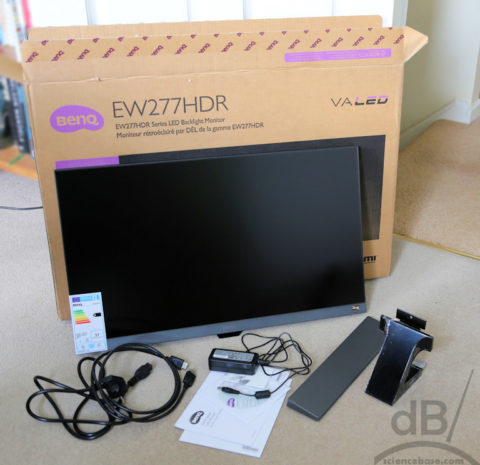It is quite timely that monitor manufacturer BenQ has just sent me their latest bit of kit to review. It is a 27-inch (68 cm) “eye-care” monitor. The device boasts that it addresses many of the problems facing home workers such as long periods of use, bright rooms, non-ideal environment and placement of monitors in home offices and so can help reduce the risk of eye strain, dry eyes, headaches, poor posture and neck and shoulder pain, and other problems some computer users face when using inappropriately sited monitors. There is mention of problems specifically associated with blue light from screens and monitors.

Having almost settled in with new digressive reading glasses – head-up focus at PC distance, eyes down focus for paperwork on the desk or phone, I was intrigued to see how it would feel to use such a monitor. On a point of order, I used to get awful headaches in my first publishing job working with paper manuscripts and proofs and accessing a mainframe computer via a VT100 terminal (one of those awful green light things). This was 1989, long before the web and although we had email and a database nothing was graphical in that office. Anyway, no headaches and no residual eyestrain almost thirty years later. So I’d no real need for a monitor that would reduce eyestrain but nevertheless willing to give it a go…
From the information, the monitor has “Brightness Intelligence”, detecting ambient light levels and colour “temperature” of surroundings and adjusting its output accordingly. It has different levels of blue output, specifically too, for different working conditions. I assume these can be overridden when one wants to calibrate for true colour work – photos, graphics, video editing, for instance.
The monitor is also flicker free (although I don’t think I’ve ever noticed flickering on any monitor I’ve used over that last three decades even with that old VT100 terminal). Maybe I am not consciously sensitive to that kind of flickering, although overhead mercury tube fluorescent lights do sometimes make me nauseous. My contact at the company suggested revealing flicker on my old monitor and the review monitor using a smartphone video capture. But, I am not entirely sure what that would prove other than the inadequacies of smartphones and frame refresh rate. If you don’t perceive/see an issue, then it’s not really an issue in this case.
An extra feature that I have not seen in any other monitor is smart focusing whereby the Window being used at any given time is highlighted more than other windows. How this works when one is working with side-by-side documents remains to be seen. Although the choice to focus on a given window is made by the user at any given time. However, my contact at BenQ tells me this is a function aimed at those watching video in a given window.
The eye-care monitor also has a High Dynamic Range (HDR) which means detail in the blacks and the highlights is more akin to how we perceive the world around us rather than the compressed world of photos and images, where very dark greys become smeary black and off-white highlights are simply blown out, as photographers would say. There is a greater colour palate than might ordinarily be found in a TV screen. That makes the computer monitor more suitable for high-resolution video rendering, and for 4K HDR gaming consoles than a lesser TV. Technically, the monitor boasts three times the contrast than normal panels, 33% greater brightness, and up to 93% DCI-p3 colour coverage. It can be setup for improved “eye-care” and for those who need high-quality video, graphics, photo editing and processing.
I am not entirely sure why the panel has a standard that makes the top lean forward further than the bottom of the screen, but more to the point there is no universal fixing bracket so I cannot install it on my adjustable cantilever desk arm and set it at the perfect height and angle for my posture and the way I work.
However, for me personally, there is a more problematic issue with such a large screen regardless of the quality or eye-care features. My new spectacles. They are digressive, which means when viewing something about 60 cm away straight on the view is nice and sharp but a movement of the eye left or right up or down as one might do frequently with a 68 cm monitor means that there is some distortion across my field of vision because the lenses are designed to focus closer towards the lower edge and indeed upper and lateral edges. Someone with 20:20 vision, or presumably conventional reading lenses, would not suffer this effect, but I am not sure I can work with the need to move my head so much to maintain focus, when I am used to a much narrower computer monitor, albeit with the same resolution. Of course, BenQ makes monitors from 21.5 to 32 inches in this range, so maybe there is a model that would suit my new specs.
The monitor is specifically a BenQ EW277HDR, which seems to be billed as a “video enjoyment” monitor elsewhere in the monitor market rather than focusing on the eye-care aspects.